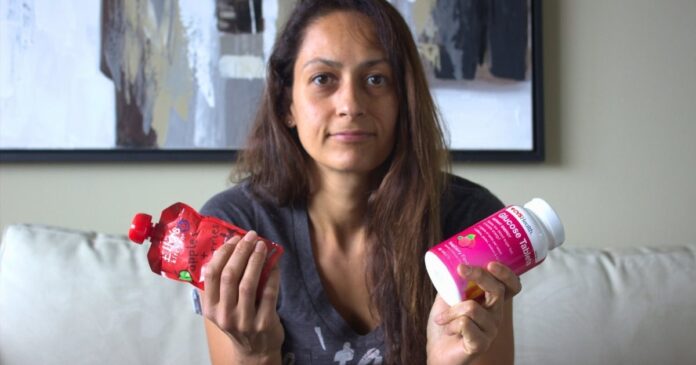Low blood sugar is one of the most challenging parts of living with insulin-treated diabetes.
If you’ve ever experienced a hypo, you know how intense it can be: the sweating, the shakiness, the brain fog, and that overwhelming urge to eat everything in sight.
After 28 years of managing type 1 diabetes, I’ve learned that treating a low effectively isn’t just about eating whatever is nearby—it’s about choosing the right foods that work fast, in the right amount, and avoiding the ones that might actually make things worse.
In the video below, I break down the top 10 best ways to raise blood sugar fast (ranked from “okay” to most effective), plus what not to grab during a hypo. I also explain how much to eat, when to stop, and why the old 15-15 rule still matters.
What Happens During Low Blood Sugar?
When your blood sugar drops below 70 mg/dL, your brain is running low on fuel. That triggers a hormonal cascade—including the hunger hormone ghrelin—that drives you to eat immediately. But not all foods will raise blood sugar quickly or effectively.
Let’s dive into the top 10 ways to treat low blood sugar, ranked by how quickly and reliably they work.
Top 10 ways to treat low blood sugar
#10: Cake
Cake might sound like the ultimate comfort food during a low, but it’s not your best bet. While it’s loaded with sugar, the high fat content slows digestion. That means slower absorption of glucose, which is not ideal when you need a quick fix.
- Glycemic Index: ~42–60
- Carb dose: ~½ slice for 15g carbs
- Verdict: Not fast enough for a serious low
#9: Ripe Banana
Bananas are natural and portable, but their moderate glycemic index means they’re better for mild lows or as a follow-up snack.
- Glycemic Index: ~51
- Carb dose: Half a large banana
- Verdict: Mild lows only; not ideal for crashes
#8: Fruit Pouches
Especially great at night, fruit pouches are mess-free and easy to keep by your bed. Most contain around 15g of carbs, but check the label—some add fiber, which can slow absorption.
- Glycemic Index: ~40–60
- Carb dose: 1 pouch
- Verdict: Easy, mild option with moderate speed
#7: Raisins
Small but mighty, raisins are a portable and effective snack. A mini box has about 15g of carbs and works quickly. Just be careful not to overeat.
- Glycemic Index: ~66
- Carb dose: 2 tbsp or 1 mini box
- Verdict: Great for on-the-go treatment
#6: Table Sugar
If you’re in a café or at home and need something quick, plain sugar works, especially when mixed with water for faster absorption.
- Glycemic Index: ~65
- Carb dose: 1 tbsp
- Verdict: Fast and reliable, but not the fastest
#5: Honey
Honey is a favorite among those who prefer “natural” options. It works fairly quickly and even absorbs under the tongue in emergencies.
- Glycemic Index: ~58
- Carb dose: 1 tbsp = ~15g carbs
- Verdict: Good middle-ground option
#4: Candy (Life Savers)
Hard candies like Life Savers (not the sugar-free kind!) raise blood sugar quickly, thanks to their high glycemic index. Just be mindful of portions—sugar is sugar, and it’s easy to overdo it.
- Glycemic Index: ~80
- Carb dose: ~4 candies
- Verdict: Quick and tasty, but portion control is key
#3: Orange Juice
OJ is a classic treatment for a reason. It’s fast, effective, and easy to drink when you’re too shaky to chew. My go-to? Kid-size juice boxes for convenience and pre-measured doses.
- Glycemic Index: ~66
- Carb dose: 4 oz (½ cup)
- Verdict: Ideal for moderate to serious lows
#2: Regular Soda
A small glass of sugary soda, like Coke or Sprite, can raise blood sugar fast. Just make sure it’s not diet! Like juice, it’s best when pre-measured or portion-controlled.
- Glycemic Index: ~63
- Carb dose: 4 oz (½ cup)
- Verdict: Fast and effective in a pinch
#1: Glucose Tablets
These are the gold standard for a reason. Glucose tabs are pure dextrose (GI of 100), highly portable, and easy to dose. You always know what you’re getting, which helps avoid overtreating.
- Glycemic Index: 100
- Carb dose: 3–4 tablets
- Verdict: Most effective, most predictable
What NOT to Eat: Dark Chocolate
Dark chocolate might seem like a treat, but it’s a poor choice during a low. The high fat content slows down digestion, which delays the glucose from hitting your bloodstream.
- Carb dose: ~1.5 oz
- Verdict: Skip it during a low—save it for dessert!
How Much Should You Eat?
Most guidelines recommend the 15-15 Rule:
Eat 15 grams of fast-acting carbs, wait 15 minutes, and recheck your blood sugar.
If you’re still low, repeat. But remember: 15 grams isn’t always the right amount for everyone. I sometimes only need 4 grams (1 glucose tab) for a morning low. The key is to track your responses and learn what works for you.
Don’t rely on CGM alone for lows
Continuous Glucose Monitors (CGMs) are incredibly helpful, but during lows, they can lag behind by up to 10 minutes. I always confirm with a fingerstick before and after treating a low, especially when deciding whether I need more carbs.
Did you find this article helpful? Click Yes or No below to let us know!

